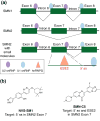Targeting RNA in mammalian systems with small molecules
- PMID: 29726113
- PMCID: PMC6002909
- DOI: 10.1002/wrna.1477
Targeting RNA in mammalian systems with small molecules
Abstract
The recognition of RNA functions beyond canonical protein synthesis has challenged the central dogma of molecular biology. Indeed, RNA is now known to directly regulate many important cellular processes, including transcription, splicing, translation, and epigenetic modifications. The misregulation of these processes in disease has led to an appreciation of RNA as a therapeutic target. This potential was first recognized in bacteria and viruses, but discoveries of new RNA classes following the sequencing of the human genome have invigorated exploration of its disease-related functions in mammals. As stable structure formation is evolving as a hallmark of mammalian RNAs, the prospect of utilizing small molecules to specifically probe the function of RNA structural domains and their interactions is gaining increased recognition. To date, researchers have discovered bioactive small molecules that modulate phenotypes by binding to expanded repeats, microRNAs, G-quadruplex structures, and RNA splice sites in neurological disorders, cancers, and other diseases. The lessons learned from achieving these successes both call for additional studies and encourage exploration of the plethora of mammalian RNAs whose precise mechanisms of action remain to be elucidated. Efforts toward understanding fundamental principles of small molecule-RNA recognition combined with advances in methodology development should pave the way toward targeting emerging RNA classes such as long noncoding RNAs. Together, these endeavors can unlock the full potential of small molecule-based probing of RNA-regulated processes and enable us to discover new biology and underexplored avenues for therapeutic intervention in human disease. This article is categorized under: RNA Methods > RNA Analyses In Vitro and In Silico RNA Interactions with Proteins and Other Molecules > Small Molecule-RNA Interactions RNA in Disease and Development > RNA in Disease.
Keywords: G-quadruplex; RNA; RNA in disease; RNA interactions; RNA structure; RNA therapeutic target; biological systems; chemical probes; expanded repeats; ligand; long non-coding RNA; mammalian; microRNA; small molecule; splice sites.
© 2018 Wiley Periodicals, Inc.
Conflict of interest statement
No conflicts of interest.
Figures







References
-
- Lander ES, Linton LM, Birren B, Nusbaum C, Zody MC, Baldwin J, Devon K, Dewar K, Doyle M, FitzHugh W, et al. Initial sequencing and analysis of the human genome. Nature. 2001;409:860–921. - PubMed
-
- Carninci P, Kasukawa T, Katayama S, Gough J, Frith MC, Maeda N, Oyama R, Ravasi T, Lenhard B, Wells C, et al. The transcriptional landscape of the mammalian genome. Science. 2005;309:1559–1563. - PubMed
-
- Mattick JS. Challenging the dogma: the hidden layer of non-protein-coding RNAs in complex organisms. Bioessays. 2003;25:930–939. - PubMed
-
- Prasanth KV, Spector DL. Eukaryotic regulatory RNAs: an answer to the ‘genome complexity’ conundrum. Genes Dev. 2007;21:11–42. - PubMed
Publication types
MeSH terms
Substances
Grants and funding
LinkOut - more resources
Full Text Sources
Other Literature Sources
Research Materials
Miscellaneous

